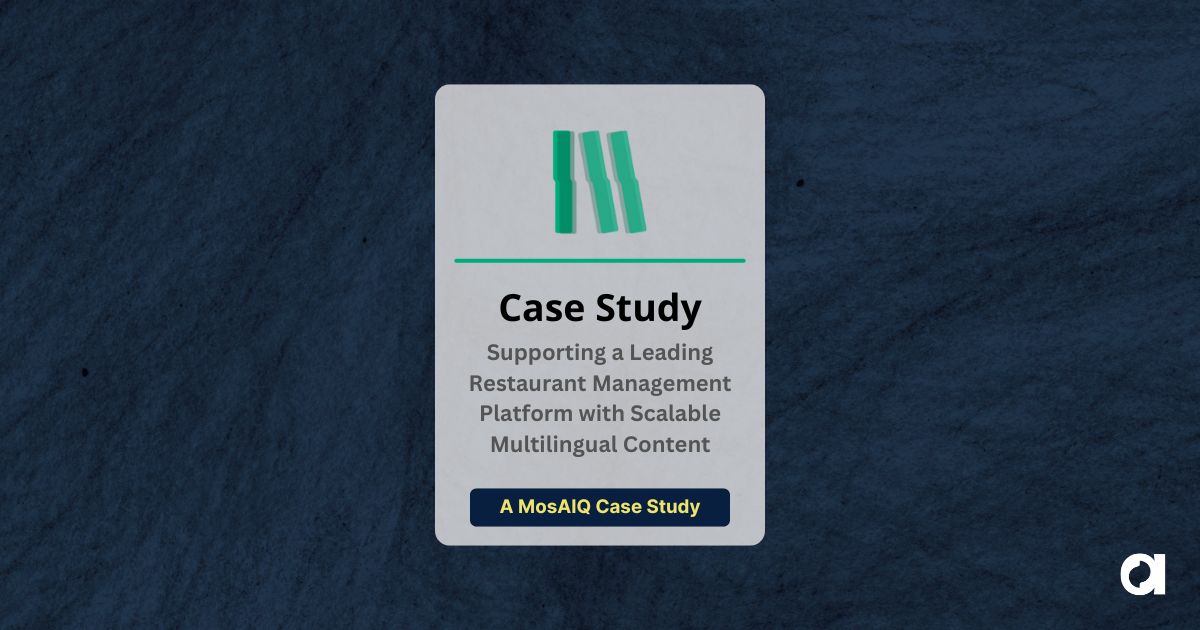Ask Better Questions: Solutions Design in a Complex World
Join Stephanie Harris-Yee and Erik Vogt for an in-depth exploration of Solutions Design and its critical role in today’s rapidly evolving localization landscape. Erik shares insights from his LocWorld presentation on how strategic thinking and systems design are transforming the way we approach multilingual content challenges.
Key topics covered:
- What Solutions Design is and why it matters now more than ever
- The three dimensions of solutions architecture: time, space, and complexity
- How AI is reshaping expectations across the entire localization ecosystem
- Five strategic recommendations for the future: from “localization” to “multilingual AI infrastructure”
- The shift from transactional workflows to outcome-based partnerships
- Building modular, hybrid workflows with governance protocols and continuous feedback loops
More “Field Notes” Episodes
Explore more topics with Stephanie and Erik in our Field Notes series, where we break down complex localization concepts into practical insights for industry professionals. Check out our other discussions on translation technology, localization strategy, and industry best practices.
- Field Notes: Connectors
- Field Notes: Are Fuzzy Matches Dead?
- Field Notes: AI LQA
- Field Notes: AI in Marketing
- Field Notes: From Idea to AI
Stephanie Harris-Yee: Hi, I’m Stephanie and I’m here with another episode of Field Notes with Erik Vogt now. Erik, I hear you did this presentation at LocWorld called Ask Better Questions: Practicing Solutions Design in a Complex World. So I know this is very much based on your experience with Solutions Design.
So let’s start with a question. What is Solutions Design?
Erik Vogt: Thank you, Steph. Solutions Design is, and I’m gonna sound like I’m reading it because I’ve thought a lot about it and trying to put it succinctly. It’s a strategic discipline of architecting how a company delivers value at a high level. So you take a problem and you turn that into an operationally executable and commercially viable, technology supported solution. So there’s three pieces and it, when you jumble it together in a sentence, it sounds like a mouthful, but ultimately it’s understanding the problem, building a viable solution that works for it. And by viable, I mean that the company isn’t gonna go out of business delivering it, and you’re utilizing and interacting with the best available tools, processes, and other resources and that can be a bunch of different things. From partners to technology, to AI to people, to the right kind of supply chain. All these things are important, critical components of what solutions design is. So in the, the presentation and breaking down this immense field, this is a very, very big field.
I broke it down into three dimensions.
Time, space, and complexity. And at that, it sounds very big time, space, a final frontier, but the time dimension manifests itself in two different important ways. One is an important way of doing the job of solutioning. So it’s a practice and it starts with discovery. There’s some good, research about this that I’m just copying. Thomas Davenport, for example, talks a lot about how do you solve problems. You start off with understanding the problem in that discovery phase. How do you do that? And then you think about putting together the solution itself and there’s a whole aspect of how do you keep track of the fragmented parts of potential solutions that could be shaped into a solution. A solution then becomes a proposal, which is, we now think we can do this, and that often is what, what the step two is often what people do. Just grab ideas and then they rush out to throw something on paper for step three. I think there’s a better way of doing it more systematically. But there’s two more steps that people often don’t think about as a solutions function. Once you win or get approval to innovate or to buy or to build. You need to implement it. And then what do you learn from this implementation process and the onboarding process?
What are your KPIs there? So one of the key KPIs of course, is the duration of time that it takes to implement and how well does it fit with that initial business problem? And then once you have implemented it, what can you take away from that? That both helps your future opportunities to say, Hey, we built this.
We should be proud of this. So do more of that or how do you learn from any of these previous four steps? You could have done better. So that’s the time dimension. We also have a space dimension, which is the degree to which it’s an interdisciplinary action. So how well does it connect different key stakeholders within, within a company ecosystem?
Now, this is just as true in a client environment as it is in a vendor environment. Just as it is for us individually as we make decisions and solve problems for ourselves. You can pick one thing that you’re usually gravitates around, certain choices, choice points, but it’s all, it’s usually as a solutions professional. You are touching and by solutions professional, anybody who’s thinking at the strategic level, you have a client who has a problem. You also have key stakeholders like legal. You have your CFO, that needs to be okay with this. You have HR how are people being utilized in this case? What partners do you have at your disposal? How do you interact with them? Your it, your InfoSec, your R&D teams, your all these different things that need to be included in this. Not to mention, hey, let’s not forget about the impact on the translator ’cause we are. In a environment in which we’re depending, not just on translator, but other knowledge workers who need to be. We need to find them, qualify them assign them, make sure that what they do is, is what we’re looking for, and then pay them. And that all this needs to be handled efficiently at scale in a highly, potentially, complex way. And then lastly, we have the complexity to mention. And at a very simple level, Steph I think you could translate my file into Chinese. I’d give you the file, you return a Chinese file, and then I’m done and I write you a check and we’re done. And then on the other end of the spectrum, we have. Seven, eight figure programs with multiple different stakeholder, internal groups, marketing product support social media engagement internal HR, all these capabilities come flowing in.
All these parameters need to be balanced against N number of languages plus different quality requirements for each, some of which are automatic, some of which are hybrid, some of which are a hundred percent human. So the complexity can be vastly complex. And you know, speaking of this complexity, I think now is the time for solutions architects out there.
And I’m talking to you, everybody who thinks of themselves all these different factors that then need to be distilled back down again into decision makers that somebody in executive often needs to write a check or needs to approve something. They need to understand it in the context of something you can explain in five minutes. So this is the big picture and then sort of zeroing it down into the, into the individual steps. And what needs to happen at each one of those steps is what I would consider the, the optimization of a solutions function.
And it couldn’t be more important than it is now because so many things are changing at once. Not only do we have AI changing the way translation is done, but it’s changing our upstream stakeholders world immensely. There’s changing expectations of end clients. There’s changing expectations of executives, there’s changing expectations of knowledge workers and individuals.
There’s a vast amount of things happening at the same time. I think there’s also the… AI is being implemented at multiple levels in our ecosystem at the same time. So clients are implementing AI in various ways upstream. I think there is one, astonishing number of the amount of things published on the internet that have basically been produced by AI now is something like 48%. It’s like insane how fast it’s getting out there. What is this gonna do to the model providers? What is this gonna do for training? What is this gonna do for how we think about the people who are trying to improve the models and what ecosystems are needed to provide the clean data needed to improve the models? Then you have people who are using AI, GenAI to create new novel content. There’s regulatory, there’s you know, ISO is getting cracked open. Like, what, how relevant is this anymore? There’s lots of things that are happening to really change the fundamental ecosystem.
So I, my argument is this is, there’s never been a more important time to be a systems thinker and to look beyond the boundaries of your silo as there is today.
Stephanie Harris-Yee: So for folks who are in this industry, the localization industry, what sort of strategic recommendations do you have for them?
Erik Vogt: Great. I’ve got five for you today. One is, I think the word localization might be obsolete. I think it’s more of a multilingual AI infrastructure might be a better word or even multilingual infrastructure. It’s a bigger picture thing, I think translation is too limiting.
You could think of it as a data labeling role. Think about data on a much broader, deeper way. So you’re, you’re thinking about prompt quality, you’re thinking about data readiness, you’re thinking about model testing. You’re thinking about building continuous feedback loops into everything. So it’s now an infrastructure design, not a transaction design. The second, design modular hybrid workflows. We are integrated, we are all these things are now, now fitting together. So it’s never been more important to have a conversation with orchestrators, with people who are building composable, low-code, no-code workflow systems and what I would love to see more of is a more systematic way of thinking about the cause and effect of these iterations. So you do a workflow test, see how it works out, do another workflow. How does this work out? There was a friend of mine who was mentioning an analysis that he did, and I won’t mention names, but he was looking at to what degree quality could be applied to a monolingual. How much, how much do you need the source to be able to determine whether the target is acceptable or not? And they did an analysis of what the changes were and where the source of the actual fix was. Is the fix related to the style guide, to glossary, to reverting back to source? And it was astonishing how little of it had to do with a source, like a very small percentage needed the source at all.
So if you’re gonna say, well maybe it’s not about matching the source, it’s more about a new set of requirements that’s far more oriented towards coherence, then that’s a different workflow that you build a different thing. So design modular, think microservices, and think hybrid flexible workflows. And my friends who are in the orchestration business there’s too many of them to name, but a few of ’em, I love dearly know who I’m talking about. That is a, an important future, but you still have to build the commercial viability of how you, how that converts to value.
So anyway, third, implement an outcome based partnership model. I’ve never seen more conversations with clients who are saying, here’s our end product, here’s what we’re trying to go for. Let’s build something collaboratively to try to build this for this particular outcome. I don’t want to buy a translation.
I want to buy a partnership. I want to buy somebody who’s gonna help me get to my end goal. There’s, I think, a lot of opportunity for service providers to think beyond. A transactional layer and more move up the buy sell hierarchy into being more of a thought leader to build with their clients rather than for their clients. So there’s different KPIs like customer satisfaction, market engagement, things like that, that are building much more into this. Four I think, governance protocols. How are you controlling the process? We know that with AI governance, things like bias. Data providence, like who owns the data.
Like how consent becomes another, a bigger issue, a linguistic quality. Of course, still an important issue. Who are you, maybe excluding through your language, are you choosing a language in a target locale? That’s oriented towards a demographic that is not actually your target demographic?
It’s all the people who speak a language don’t have the same… they’re not the same people. Like there is a bigger group than that. So is the language that you’re using to translate into even the right language for your target audience? So the governance protocols helps you to sort of think about the bigger picture here of where this data is going.
And then last skills and structural maturity. I think we don’t want to keep doing better a task that doesn’t need to be done. We need to be systematic about what this means. So I think there’s data. There’s language and there’s business, and that always has been what our industry is about. Those three put together in one form or another. Tech, language, business. So now we are looking at, different kinds of thinkers there. You’re thinking about an AI QA specialist who doesn’t just look at compliance with the source, for example, but compliance towards are you fitting into how does this language affect your CSAT scores? For example can you partner with the right group of stakeholders to refine, build a feedback loop into the translation to end user behavior, back to the translator again, instead of just to the source and back again?
So those things are an important way of thinking about it. So our skills are needed. The structural maturity is needed to evolve to a bigger level. So reframing the problem. Think modular, think hybrid. Think about outcome-based sort of mindset. You’ll see a lot of the topics at the last conference is talking about outcomes more than ever. Governance and of course the skills and the human dimension and where they fit in and how do you evaluate them.
Stephanie Harris-Yee: All right. I think that’s all the time we have for today, but thank you so much Erik, and this discussion on solutions and design gives me a lot to think about for the future.
Erik Vogt: I can’t shut up about it. I really love talking about this.
 Argos Multilingual
5 min. read
Argos Multilingual
5 min. read
Localizing images has never fit neatly into standard workflows. Screenshots, graphics, and UI flow images contain text that translation tools can’t read, so teams handle them as separate tasks that take extra time and coordination. MosAIQ ImVisio creates a simple, scalable workflow for visual assets using automated image translation and structured review. The AI-powered tool […]

 Argos Multilingual
6 min. read
Argos Multilingual
6 min. read
Multimedia localization once focused on language, layout, and timing. As of 2025, it also has to meet digital accessibility standards. With the EU Accessibility Act now in force, organizations are expected to make every digital asset, from videos and training programs to internal communications and eLearning courses, part of a broader accessible multimedia strategy. That […]











